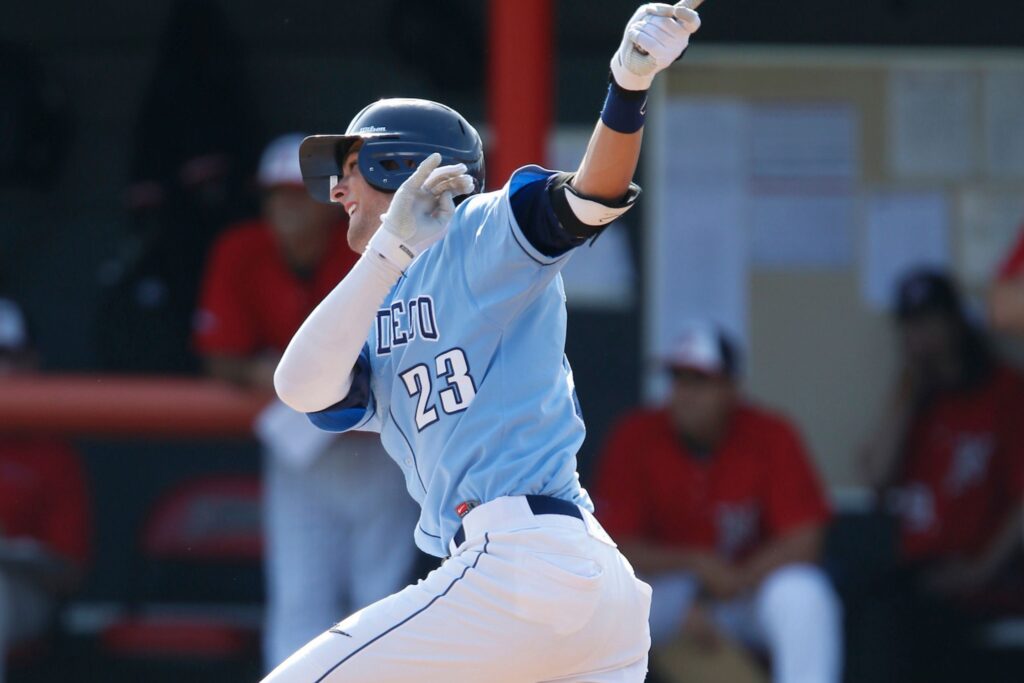Image credit:
Kris Bryant (Larry Goren/Four Seam Images)
College baseball has produced its share of legends in the past quarter-century, but narrowing down the field to create a lineup featuring the very best of the best collegiate players requires a sharp lens.
The rules for inclusion were straightforward: Every player considered had to have played at least part of his college career in 2000 or later. Beyond that, the measure tilted heavily toward what players accomplished during their time on campus. Professional success, prospect pedigree and even team performance mattered only at the margins and were used to separate close calls rather than define greatness.
At its core, this project was about rewarding dominance, consistency and impact at the college level. This list, curated with feedback from the Baseball America staff, scouts and college coaches, is ultimately meant to honor the standout college players whose careers most shaped the sport since the turn of the century.
Here is Baseball America’s All-2000s College Baseball Team:
C: Buster Posey, Florida State (2006-08)
While Adley Rutschman and Mike Zunino both had strong cases for the catcher position, Posey’s extraordinary 2008 season cements him as the choice.
That year, Posey authored one of the greatest campaigns in college baseball history, hitting .463/.566/.879 with 26 home runs, 93 RBIs and 51 extra-base hits. The performance earned him Baseball America’s Player of the Year award, propelled Florida State to the College World Series and vaulted him to the No. 5 overall pick in the draft.
Posey began his Florida State career as a shortstop in 2006 before moving behind the plate as a sophomore, where he quickly became the nation’s premier catcher. His college dominance carried into a decorated professional career, highlighted by a 2012 NL MVP award and three World Series titles with the Giants.
1B: Dustin Ackley, North Carolina (2007-09)
The second-overall pick in the 2009 draft, Ackley ranks among the most accomplished hitters in college baseball history. He batted .412/.489/.648 with 39 home runs and 59 doubles across three seasons, recording at least 100 hits each year. North Carolina reached the College World Series in all three of his campaigns, including a runner-up finish in 2007 with Ackley anchoring the lineup.
A pure hitter with elite bat-to-ball skills, Ackley likely would have threatened the all-time NCAA hits record had he returned to school for his senior season.
2B: Rickie Weeks, Southern (2001-03)
Though he faced weaker competition than most others on this list, Weeks’ production was so overwhelming that it still stands as some of the greatest in college baseball history.
Weeks’ batting average went from .422 as a freshman in 2001 to .495 as a sophomore—he also added 20 home runs that season—and then to .479 as a junior when he won College Player of the Year honors. Over three seasons, he hit 50 home runs, stole 65 bases and was caught stealing just once. Weeks remains the NCAA’s all-time record holder in career batting average at .465, a mark that underscores his place as one of the sport’s most dominant hitters.
3B: Kris Bryant, San Diego (2011-13)
Few players thrived in the dead-ball BBCOR era the way Bryant did. Consider that, in 2013, UCLA won the national championship hitting only 19 total home runs as a team while Indiana’s Kyle Schwarber finished third in the country with 18 homers. Bryant, meanwhile, flashed his outlandish power to belt a nation-leading 31 home runs, nearly doubling anyone else in Division I and capturing College Player of the Year honors before going second overall in the draft.
Bryant closed his San Diego career with a .353/.486/.702 slash line, 54 home runs and 47 doubles, establishing himself as one of the early BBCOR era’s rare, undeniable power threats.
SS: Khalil Greene, Clemson (1999-2002)
Few players on this list stayed in college for a full four years, and that longevity inevitably helped Greene’s career totals swell in the record book. But even accounting for that, his performance—particularly as a senior—made him impossible to ignore.
In 2002, Greene authored one of the most outrageous offensive seasons ever by a shortstop: .470/.552/.877 with 27 home runs, 33 doubles, 91 RBIs and 46 walks against just 22 strikeouts. The campaign earned him Baseball America’s Player of the Year award, making him the last shortstop to claim the honor until UCLA’s Roch Cholowsky did so more than two decades later. Greene left Clemson as the NCAA’s all-time leader in doubles with 95 and ranks second in career hits with 403.
OF: George Springer, Connecticut (2009-11)
From the moment Springer arrived on campus in 2009, it was clear UConn had something rare. As a freshman, he batted .358 with 16 home runs, earning Freshman All-America honors and establishing himself as one of the nation’s most dynamic newcomers. His sophomore season only reinforced that promise, as he hit .337 with a career-high 18 home runs, pairing power with speed and defense. By the time he was a junior, Springer had developed into All-America form, as he slashed .350/.458/.624 while driving in a nation-leading 77 runs, swiping 31 bases and racking up 38 extra-base hits.
Those numbers reflected Springer’s presence as a complete player who could carry a lineup, and they helped put UConn baseball on the national map in a way it hadn’t been in decades. His three-year run in Storrs left behind one of the most complete resumes of any college outfielder of the last 25 years.
OF: Jacoby Ellsbury, Oregon State (2003-05)
Ellsbury was one of the best pure hitters of the 2000s, batting .365/.464/.522 across three seasons in Corvallis while adding 60 stolen bases and standout defense in center field. His best year came in 2005, when he hit .406/.495/.582 with six home runs, 19 doubles, 26 stolen bases and nearly as many walks (36) as strikeouts (21).
Ellsbury’s combination of contact, speed and defense made him the catalyst for Oregon State’s rise to national prominence and helped set the stage for the Beavers’ back-to-back national titles that followed his departure.
OF: Charlie Condon, Georgia (2023-24)
Condon is the first player on this list whose career unfolded entirely in the transfer portal era, when offensive numbers have surged. Even in that setting, his two-year run at Georgia stood out. He hit 65 home runs, including a BBCOR-era record 37 as a draft-eligible sophomore in 2024, when he batted .433, drew 57 walks and was intentionally walked 28 times.
That season earned Condon Baseball America’s Player of the Year honors and solidified his place among the most productive two-year players of the modern era.
DH: Jac Caglianone, Florida (2022-24)
The cases for Caglianone and Brendan McKay are nearly interchangeable, as both left lasting marks as true two-way players. Caglianone gets the DH spot here because his offensive output was greater, while McKay was the superior pitcher with strong offensive numbers of his own.
At the plate, Caglianone was unmatched in the 2000s era, becoming the only player to post multiple 30-home run seasons. He finished as the nation’s home run leader of the quarter century and tied for eighth on the NCAA’s all-time list. On the mound, he gave Florida valuable innings as its third starter, working to a 4.55 ERA with 170 strikeouts over 148.1 career innings. That combination of prodigious power and legitimate contributions on the hill makes Caglianone one of the most unique players of the last 25 years.
Two-Way Player: Brendan McKay, Louisville (2015-17)
While Caglianone gets the nod at DH for his prodigious power, McKay takes the two-way slot because his pitching was on another level. Over three seasons at Louisville, he was a strong hitter in his own right, slashing .328/.430/.536 with 28 home runs, 48 doubles and 132 RBIs while maintaining nearly a one-to-one strikeout-to-walk ratio.
On the mound, though, McKay was elite. He logged 315.1 innings with a 2.23 ERA, striking out 391 against 111 walks—numbers good enough to rank him among the top pitchers of the last 25 years. His best season came in 2017 when he earned Baseball America’s Player of the Year honors by striking out 146 over 109 innings with a 2.56 ERA while also hitting .341 with 18 home runs, 15 doubles and more walks (45) than strikeouts (39). Few players of the modern era matched his balance of production on both sides of the ball.
SP: Stephen Strasburg, San Diego State (2007-09)
Strasburg broke in as a freshman reliever in 2007, flashing his potential with a 2.43 ERA, 47 strikeouts and seven saves across 37 innings. By the following season, he had moved into the rotation and quickly established himself as the most dominant arm in the country, posting a 1.57 ERA with 133 strikeouts against just 16 walks in 97.1 innings. He somehow surpassed those numbers in 2009, finishing with a 1.32 ERA and 195 strikeouts to only 19 walks over 109 innings.
That campaign earned Strasburg Baseball America’s Player of the Year award and cemented his place as the No. 1 overall pick in the draft. His blend of velocity, command and pure dominance over three seasons remains the standard against which elite college pitchers are measured.
SP: Paul Skenes, Air Force/LSU (2021-23)
Strasburg’s run may stand alone in college baseball history, but Skenes came close to matching it in 2023. In his lone season at LSU, the future No. 1 overall pick delivered a 1.69 ERA with 209 strikeouts against 20 walks over 122.2 innings, leading the Tigers to a national championship. His strikeout total ranks ninth all-time and remains one of the most dominant single-season pitching lines of the modern era.
Skenes wasn’t just a one-year wonder, though. Pitching for Air Force, he logged ERAs of 2.70 and 2.73 as a freshman and sophomore, striking out 126 across 112.1 innings. He also swung the bat during those two years, hitting .367/.453/.669 with 24 home runs before transitioning exclusively to the mound. With overpowering stuff and the rare ability to impact games in multiple ways, Skenes carved out one of the most memorable careers of the last quarter century.
SP: Thomas Eshelman, Cal State Fullerton (2013-15)
Eshelman built his reputation on command, and no pitcher in college baseball history has ever done it better. Across 376.1 career innings, he issued just 18 walks while striking out 321, giving him an all-time record 0.43 walks per nine innings (minimum 100 innings).
That precision defined a three-year run of steady dominance for Cal State Fullerton. He opened with a 1.48 ERA as a freshman in 2013, followed with a 1.89 mark over 123.2 innings as a sophomore and capped his career with a 1.58 ERA across 137 innings in 2015, when he helped guide the Titans to the College World Series.
Eshelman might not have had the overpowering stuff of some of his contemporaries, but his combination of efficiency, durability and unmatched control places him firmly among the best pitchers of the era.
SP: Jered Weaver, Long Beach State (2002-04)
Weaver was one of the defining West Coast arms of the early 2000s. Over three seasons at Long Beach State, he pitched to a 2.43 ERA with 431 strikeouts against 73 walks across 370 innings, establishing himself as one of the most reliable and durable starters of the era.
Weaver’s junior year in 2004 was the peak. That season, he posted a 1.63 ERA with 213 strikeouts to just 21 walks in 144 innings—a performance that earned him Baseball America’s Player of the Year honors. That strikeout total remains the most in a single season in the last 25 years, a testament to both his dominance and his workload. Few pitchers blended production and stamina as effectively as Weaver, whose career still stands as a benchmark for college aces.
RP: David Berg, UCLA (2012-15)
Berg arrived at UCLA as a walk-on sidearmer and immediately became a fixture out of the bullpen. He appeared in an NCAA-record 51 games as a freshman in 2012 and went on to set the all-time mark with 175 career appearances. Over four years, he posted a 1.11 ERA with 241 strikeouts and 49 saves, including an NCAA-record 24 in 2013 when the Bruins captured the national championship.
Berg’s unorthodox style and remarkable durability made him a unique weapon in an era when bullpens were rarely built around a single arm. Though his professional career was brief, his college resume leaves little debate about his standing as one of the greatest relievers the sport has ever seen.
RP: Huston Street, Texas (2002-04)
Street set the standard for the modern college closer a decade before Berg. In three seasons at Texas, he logged 178.1 innings with a 1.31 ERA, striking out 177 against just 35 walks. He finished with 41 career saves, joining a short list of pitchers to eclipse the 40-save mark.
Street’s dominance helped anchor Texas’ bullpen during one of its most successful stretches, and his blend of power stuff and reliability made him a prototype for the role. While Berg’s volume and longevity gave him the all-time records, Street’s efficiency and consistency still place him firmly in the conversation for the best college reliever of the last quarter century.
Discover more from 6up.net
Subscribe to get the latest posts sent to your email.


